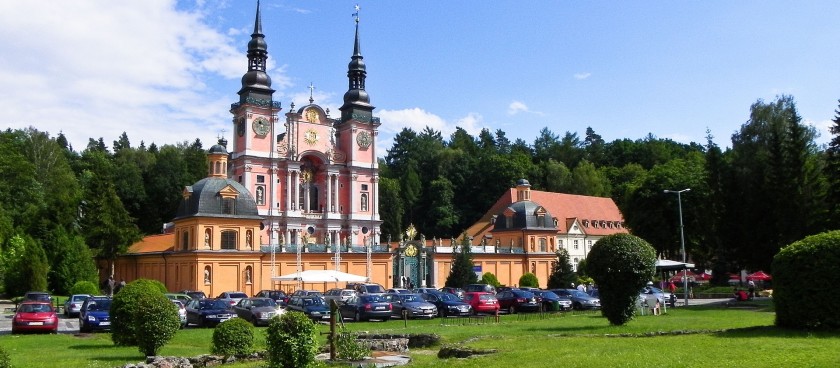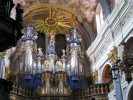- #PL12
- Św. Lipka 29, Reszel, Poland
- +48512730375
- sanktuarium@swlipka.pl
- swlipka.pl
- Working hours*:
May - September
6:30 - 20:00
April and October
6:30 - 18:00
November - March
November 6:30 - 18:00,
December-March 9:30 - 15:30 - * - opening and closing times as well as entrance prices, are subject to alterations without notice. Visitors are advised to check before visiting.
- 54.0249060, 21.2176050 Copy to clipboard Copy
-
#Churches
History
Saint Lipka is a famous Marian sanctuary. It lies at the northern end of Poland, about 70 kilometers northeast of Olsztyn and 6 kilometers east of Reszel. The beginnings of the Marian sanctuary date back to the 14th century and we know them only from folk stories passed orally for several centuries. We have the most information in documents written and published in the 17th century. The author of one of the magazines talks about the beginnings of Saint Lipka: "There is a famous place in Prussia, which took its name from the lime tree, for a long time there was a spreading lime tree on this place, and on it almost the first seeding of Christianity in Prussia - a figurine of the Mother of God appeared with the Child, the work of the hands of God. " Saint Lipka has come to history from the beginning as a famous pilgrimage site. Already in the Middle Ages the custom of organizing pilgrimages to Saint Lipka was established, to which Pilgrims, not only from Prussia and Warmia, but also from Mazovia, came to obtain indulgence and in the hope of healing. The last great Teutonic master Albrecht Hohenzollem in 1519 he went on foot and barefoot from Königsberg to Saint Lipka.
In 1525, the Catholic faith was banned in the Prussian state, and the cult of saints was considered a superstition. The crowd from Kętrzyn robbed and demolished the chapel, the lime was cut and the figurine was drowned in the Swirl Lake. In 1618, Catholics regained their religious freedom, and the secretary of King Zygmunt III Stefan Sadorski bought all Saint Lipka. The administration and the right of use of Saint Lipka were handed over to the Jesuits.
A chapel was built, in which a copy of the picture of Our Lady of the Snows was placed. The reconstruction of the chapel began the flourishing of the sanctuary. In Prussia and Warmia it was difficult to find a man who would not come to Święta Lipka on a pilgrimage for once. In 1685, the Jesuits prepared the area for construction, collected materials, cut down a part of the hill, swamps were filled, and the ground was strengthened by drenching thick long alder piles with iron at the end. The cornerstone was consecrated by the Bishop of Warmia Cardinal Michał Radziejowski 1.XI. 1687. The church was consecrated on August 15, 1693 by the bishop Jan Stanisław Zbąski with great splendor in the presence of numerous clergy and thousands of believers. The church did not accommodate all pilgrims, that's why a cloister with corner chapels was built. The interior design lasted for over fifty years.
The main altar, side altars, artfully made tabernacle, organ, frescoes in the church and in cloisters, a forged gate, stone and wood sculptures, works of artistic blacksmithing and ironwork - all this is what Saint Lipka is a "Pearl of the Baroque" - an object of extraordinary historic value , one of the finest specimens of late Baroque in Poland. After the suppression of the order, the Jesuits returned to Święta Lipka in 1932. They undertook work connected with the parish and the sanctuary. After the war, the fame of the Sanctuary grew, pilgrimages began to visit and the cruise traffic increased. New classes have arrived: guiding pilgrims and tourists, explaining the history of the sanctuary and presenting the organs. After the war, costly conservation works are continually being carried out, which are financed mainly from the victims of pilgrims and tourists arriving from Poland, Germany and around the world.
In the main altar there is an image of the Mother of God, modeled on the icon of the Mother of God from the Roman Basilica of the Greater Mother of God. At the order of the Jesuits, it was made in 1640 by Bartłomiej Pens, a Belgian living in Elbląg, who after moving the city by the Swedes permanently moved to Vilnius. Samuel Gräwe - a goldsmith from Królewiec made a silver dress for this painting, silver ornaments on the tabernacle with the scene of the Last Supper and Supper in Emmaus and a monstrance in the shape of a lime tree with a figurine of the Mother of God. The Mother of God in this image is venerated as the Mother of Christian Unity. The painting was decorated with papal crowns on August 11, 1968. The Primate of Poland Fr. Cardinal Stefan Wyszyński, and the sum was celebrated by Fr. Cardinal Karol Wojtyla. Pope John Paul II, by decree of 241 February 1983, gave the church in Saint Lipka the title of the Minor Basilica. On the thirtieth anniversary of the consecration of the church, a scientific symposium devoted to Felix Nowowiejski was held in Święta Lipka, and the main jubilee celebration with the Polish Episcopate took place on June 20, 1993. Since 1989, during the holiday period, the "Holy Polish Musical Evening" takes place on Fridays 20:00. The main indulgences: the indulgence of the Visitation of the Virgin Mary on the last Sunday of May where the pilgrims go to Święta Lipka in the "Gwiaździsta" walking pilgrimage from Reszel, Kętrzyn, Mrągowo, Giżycko and nearby parishes and indulgences on August 15 in the Feast of the Assumption. The Evangelicals also come to Our Lady of Święta Lipska today.



